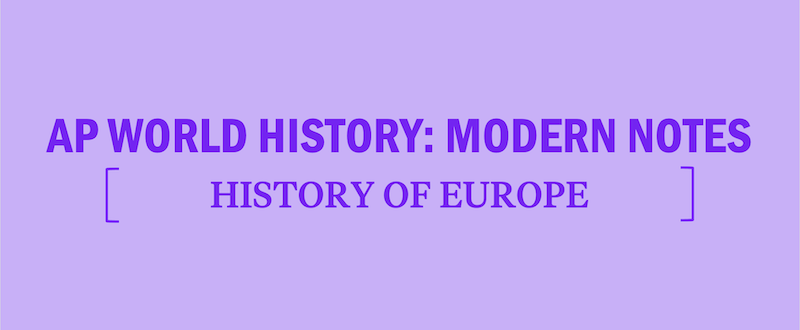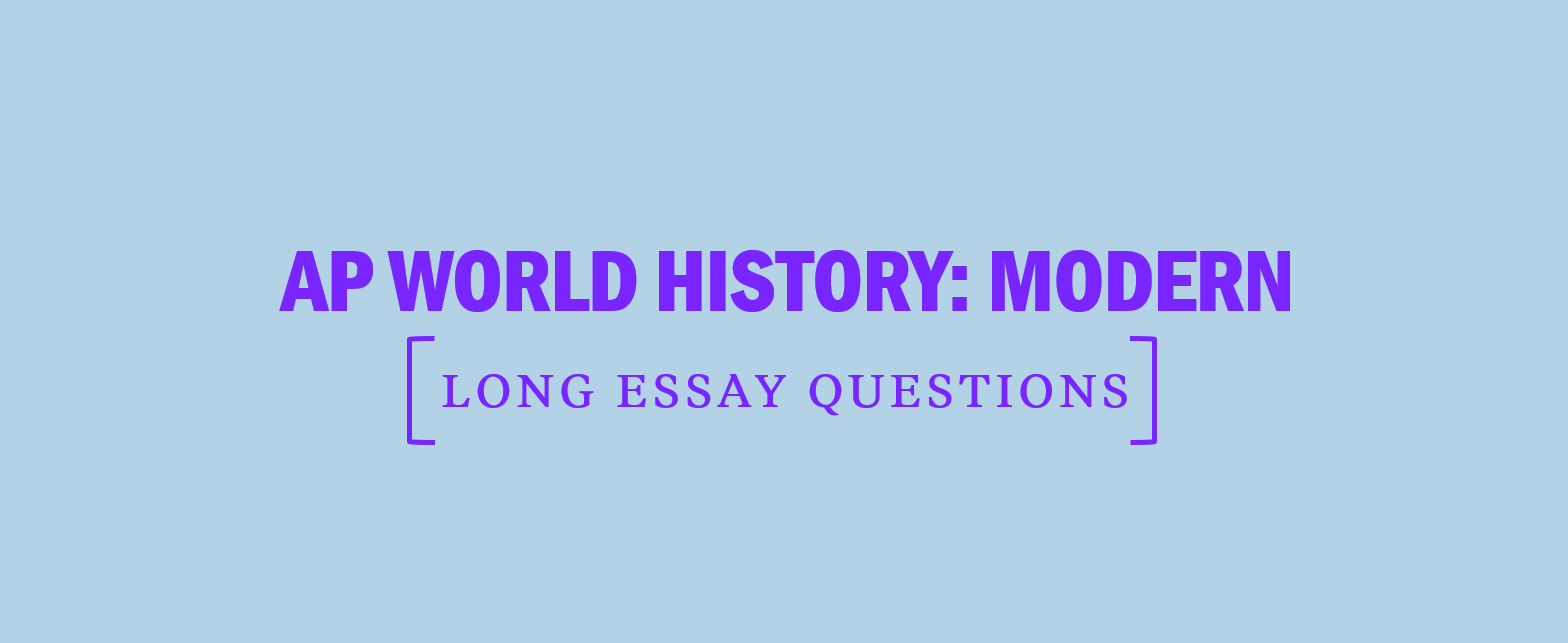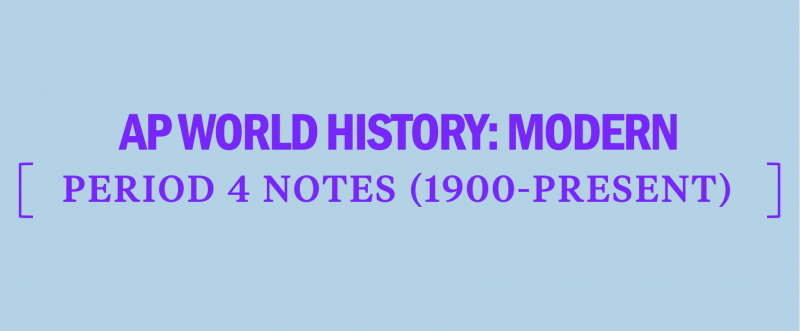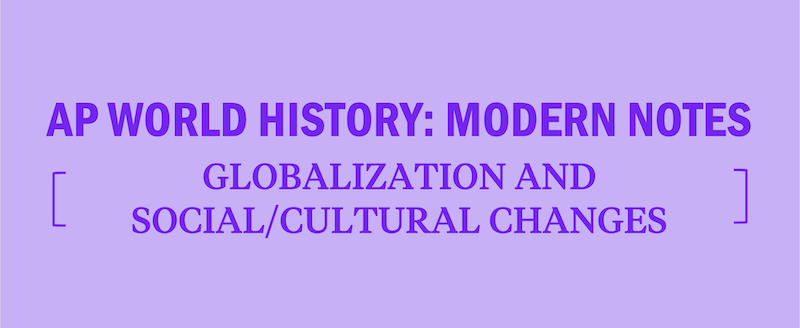History of Europe—AP World History: Modern Notes
Early European history set the stage for the significant world developments to follow. Read on for key events, periods, and developments in European history to prepare for success on the AP World History: Modern Exam.
Table of Contents
- Europe During the Late Middle Ages
- European Renaissance
- Protestant Reformation
- Scientific Revolution
- The Enlightenment
- Unification of Italy and Germany
Europe During the Late Middle Ages
European Political Development
Compared to Byzantium, China, and the Islamic world, Western Europe remained politically decentralized following the decline and fall of the Western Roman Empire. Instead, Europe developed a system of feudalism, in which lords gave lands to vassals in exchange for military service and loyalty. This system allowed various lords and vassals to compete for power, in the absence of central authority. The one centralizing power in this period was the Roman Catholic Church and its ruler, the pope. By the thirteenth century, the Church owned approximately one- third of Western European land.
The absence of a strong central authority led many peasants to seek protection on large estates. These peasants became serfs; they had the right to work a portion of the land and could pass that right on to their children, but they could not leave their land. Serfs could keep a portion of their harvests, but they sent the majority of their earnings to their lord. In addition, serfs paid taxes for using their lord’s mill, provided labor during agricultural off-seasons, and sent gifts on holidays to their lords. Lords’ estates became large, walled manors that were economically self-sufficient. They maintained mills, bakeries, and breweries. They had private armies served by knights.
Birth largely determined one’s social status. Marriage was the key to political power, and marital alliances were crucial to a family’s continued social success. Women also entered convents, where some women could exercise leadership skills. Noblewomen had more power and authority than peasant women and could inherit land if they were widowed or without sons.
However, feudalism was not a uniform system. There were regional variations that are important to distinguish. French feudalism perhaps best fits the classic decentralized model described above. English feudalism developed along different, more organizationally cohesive lines. The Magna Carta, written in 1215, outlined specific rights and duties that the monarchy, English nobility, and Church all had to observe. The Italian city-states boasted a feudalism that was more socially fluid, with birth not necessarily cementing social status.
In Eastern Europe, feudalism developed along more stringent lines than in France. The development of serfdom there firmly anchored the peasantry to the land they worked. In many towns and villages throughout Russia, serfdom functionally continued until the Communist Revolution in 1918.
European Cultural Development
Christianity was the principal source of religious, moral, and cultural authority throughout the Middle Ages, and strong papal leadership contributed to this authority. The Roman Catholic Church developed a strong hierarchy, which consisted of a pope, cardinals, archbishops, bishops, and priests. Monasteries, building complexes where monks dwelled, also developed throughout Europe. These sites often maintained large landholdings and served as refuges for individuals in need. Monks preserved classical knowledge by hand-copying great works of literature and philosophy.
The end of the Medieval Warm Period, which lasted from roughly 950 to 1250, meant that the European climate cooled. Crop yields shrank and food prices rose as nations like France experienced their first famines in centuries. The Great Famine of 1315–1317 killed millions across Europe. Food shortages were so severe that widespread incidents of cannibalism and of children being abandoned may have provided the basis for fairy tales like Hansel and Gretel.
From 1337 to 1453, the English and French fought the Hundred Years’ War. This conflict resulted in England losing its possessions in continental Europe save for Calais in northern France, and it led to a rejection of French culture in England. Both kingdoms developed their national identities due to their long-running clash with one another, with France gaining a national heroine in Joan of Arc. The French monarchy gained greater power as the formerly loosely bound kingdom centralized in order to prosecute the war. The growth of power in both monarchies, especially in terms of collecting taxes and organizing professional armies, contributed to the decline of feudalism in Western Europe.
European Economic Development
As Europeans interacted with other regions, they adopted new agricultural techniques, such as the three-field system of crop rotation, and foreign agricultural technologies, such as iron plows, watermills, and horse harnesses. These innovations increased crop production and population sizes in Europe. While the traditional feudal economy was solely based on agriculture in the countryside, a new premodern economy was evolving by 1100. During the early medieval period, the old Roman towns decreased in size. Now, after centuries of decline, increased trade began to stimulate the growth of commercial cities in the heart of Europe. Most often located on riversides, these towns grew into marketplaces and adopted foreign financial innovations, such as banks and bills of exchange. Some representative examples of these new urban centers included:
- Bruges: Located on a river system that connected the North Sea with Central Europe along the Rhine River, its cross-channel trade brought raw wool from England, which was converted into clothing to sell.
- Hamburg: A major port on the North Sea. Hamburg was part of the Hanseatic League, an alliance of trading cities and their merchant guilds, which controlled trade along the Northern European coast. The League regulated taxes and created rules for fair trade among the member cities.
- Florence: Central Italian city that controlled the flow of goods through the peninsula. Called the Republic of Florence, this city-state became a center for banking and commerce by 1300.
Service providers and craftspeople set up businesses in these towns, further stimulating growth. Among those providing services were barbers, blacksmiths, coopers (barrel makers), jewelers, leatherworkers (tanners), innkeepers, and merchants of beer and wine. These cities began to plan their growth, regulate business, and collect taxes. Wealthy towns in Italy invested in new buildings and statuary for beautification.
The Crusades
The Crusades were a series of Christian holy wars conducted against infidels—nonbelievers. The most significant crusade was a massive expedition led by the Roman Catholic Church to recapture Palestine, the land of Christian origins, from the Muslims. Pope Urban II launched the Crusades in 1095, when he urged Christian knights to take up arms and seize the Holy Land. After the First Crusade, the Christians captured Edessa, Antioch, and Jerusalem and divided that territory into feudal states. However, the Muslim forces reorganized under the leadership of Saladin and retook Jerusalem in 1187. The Fourth Crusade never made it to the Holy Land. The crusaders, supported by the merchants of Venice, conquered and sacked the Byzantine capital of Constantinople in 1204. This event severely weakened the Byzantine Empire.
Though the quest for the Holy Land was a failure, it led to great economic developments in Europe. It encouraged trade with Muslim merchants and increased the European demand for Asian goods. As a result, Italian merchants from cities such as Venice and Genoa greatly profited, and Europe was reintroduced to the goods, technology, and culture of the other regions.
European Renaissance
In the early fifteenth century, beginning on the Italian peninsula, new ways of thinking about the nature of humanity and the world emerged. The Crusades had brought southern Europe into contact with the Arab world, increasing international contact and trade. Scholars uncovered long- lost Roman and Greek literature that had been preserved by Islamic scholars. In reference to this reemergence of ancient knowledge, this intellectual revival became known as the Renaissance, or rebirth. Hallmarks of the Renaissance include: a new view of man as a creative, rational being; a rediscovery of ancient Greco-Roman knowledge; unparalleled accomplishments in literature, music, and art; as well as a celebration of the human individual.
Renaissance Italy was a patchwork of feudal domains, with lands belonging to the Roman Catholic Church, kingdoms, and city-states. Famous noble families such as the Medicis had grown wealthy as merchants, since Italy was ideally located for receiving goods from the Middle East and Asia along Mediterranean trade routes. This lucrative trade with the Islamic and Byzantine cultures allowed wealthy Italians to become patrons of painters, sculptors, and scientists. The period was also a celebration of the Roman past; classical architecture and engineering were reexamined and relearned.
Perhaps the single most important technological and cultural development of the Renaissance was the printing revolution. In 1456, Johann Gutenberg of Germany printed a complete edition of the Bible using the first printing press in the West (the Chinese had been using movable type for centuries). This printing revolution brought enormous changes to Europe. Printed books were less expensive and easier to read than copied manuscripts. The increase in the availability of books led to a rapid rise in literacy. European readers gained access to a wide range of knowledge on subjects including medicine, law, mathematics, and philosophy. Along with helping to spread classical knowledge and Renaissance ideas, these new printing presses helped fuel a European religious upheaval during the 1500s: the Protestant Reformation.
Protestant Reformation
Just as the Renaissance inspired an era of exploration, it also created an atmosphere that encouraged debate and criticism of the existing order. The most powerful institution of the day was the Catholic Church, headquartered in Rome. It had held great power over kings and peasants alike for centuries, and it had grown large, wealthy, and corrupt. Practices such as selling forgiveness and salvation began to offend even those in the priesthood.
A movement to reform the Church grew out of these concerns. In 1517, in the German domain of Wittenburg, a then-obscure priest named Martin Luther posted a list of issues that he believed the Church should address. The main issues raised by the Protestant Reformation were:
- Divisions within the papacy, in which more than one pope claimed authority (“antipopes”)
- Religious traditions and rituals that were not derived from the scriptures (such as purgatory, pilgrimages, and worship of the saints)
- Corrupt practices such as the sale of religious relics and indulgences (forgiveness)
- Mismanagement of Church finances
- Lack of piety in the priesthood
Martin Luther and his fellow reformers unleashed a storm of controversy that eventually split the Catholic Church and divided Europe. Luther was excommunicated from the Church but gained the sympathy of German princes who adhered to his version of Christianity. At the time, German lands were divided into hundreds of small kingdoms and ruled by the Holy Roman Emperor, in this case Charles V of Spain, a staunch Catholic. Many of the northern German princes resented having to support both the Church and a non-German emperor. The German kingdoms became divided into two armed camps: Catholics siding with the Church and Protestants siding with Luther. The resulting conflict devastated German lands, but ended in a treaty (the Peace of Augsburg, 1555) that enabled each prince to decide which religion—Catholic or Lutheran—would be the religion of his domain. Most states in northern Germany chose Lutheranism, while the south remained largely Catholic. This was the doctrine of Cuius regio, eius religio (“whose realm, his religion”).
The Thirty Years’ War
The religious upheavals of the Protestant Reformation came to a violent conclusion with the Thirty Years’ War. The Peace of Augsburg had not resolved the religious tensions between Catholicism and Lutheranism, nor did it account for the rise of other Protestant denominations like Calvinism. Spain sought to expand its hold over the Netherlands into the German states. France likewise sought influence in Germany, and the Catholic kingdom found itself backing Protestant German states. Northern European countries like Sweden sought control over the Baltic Sea.
The result, from 1618 to 1648, was a war that devastated Central Europe and Italy. The Thirty Years’ War ranks among the worst catastrophes in European history. Half the male population of Germany died. The Czechs lost a third of their prewar population. Geopolitically, the map of Europe was rewritten. Spain lost control of Portugal and the Netherlands. France enjoyed an upswing in its geopolitical power. The Peace of Westphalia in 1648, which ended the war, is notable for establishing the foundation of the modern nation-state. The ruler of a given state was now paramount, with any other religious or secular authority not able to claim control over the people of that state. The widespread, horrific actions taken by mercenary armies during the war, as well as the strengthening of central state authority during and after the war, led to European states favoring professional national armies over mercenaries. The Thirty Years’ War was also the last major religious war in continental Europe.
Scientific Revolution
The development of modern science and Enlightenment philosophical ideals had a tremendous impact on the development of the modern world and the modern mentality. Prior to 1500, scholars relied mostly on classical texts and the Bible to answer questions about the natural world. The Scientific Revolution began as scientists challenged conventional ideas and used observation to understand the structure and composition of the universe. The Polish cleric and astronomer Nicolaus Copernicus paved the way for modern astronomy when he put forth a heliocentric theory of the universe in 1543, contradicting the Church’s belief in an Earth-centered universe. Building on this revolutionary discovery, the Italian scientist Galileo Galilei constructed his own telescope in 1609 and used it to develop new theories about the universe. His findings angered both Catholic and Protestant leaders because they challenged Biblical accounts and the authority of the Christian churches. In fact, Galileo was put on trial before the Inquisition and forced to read a signed confession in which he stated that his ideas were false.
The Scientific Revolution led to the development of the scientific method, a logic-based approach to testing hypotheses through observation and experimentation. Use of the scientific method led to significant advances in the fields of physics, biology, medicine, and chemistry, as well as to the development of the social sciences in the late nineteenth century.
The Enlightenment
Two English political thinkers, Thomas Hobbes and John Locke, lived through the horrors of the English Civil War. Despite this shared experience, each man came to strikingly different conclusions about human nature and the proper form of government. Their ideas provided the philosophical foundation for the Enlightenment.
Locke believed in self-government. According to Locke, people possess natural rights to life, liberty, and property, and government’s purpose is to protect these rights. If government fails at this job, Locke reasoned, the people had the right to overthrow it. This notion later inspired revolutionary thought in Europe and the Americas.
Hobbes, by contrast, believed a strong ruler was the foundation of any social order. Anything less led to destructive chaos. Unlike Locke, who argued natural rights were intrinsic to humanity, the Hobbesian position was that rights exist because of the state. Only through a strong ruler and the willing submission of the people to the laws of that ruler can rights exist. Otherwise humans enjoyed no rights or freedoms.
Though it started in England with the work of Hobbes, Locke, and the publication of Isaac Newton’s Principia Mathematica in 1687, the Enlightenment was centered in Paris, where it reached its peak in the mid 1700s. There, intellectuals called philosophes gathered to discuss politics and ideas. The philosophes believed that reason (one of their primary areas of interest, along with nature, happiness, progress, and liberty) could be applied to both human relationships and the natural world. The Enlightenment emphasis on free thought led to the questioning of traditional authority. Both the Church and the monarchy were challenged, and the political radicalism of the Enlightenment caused great anxiety in the courts of Europe.
However, the Catholic and Protestant churches were not necessarily wholly uninvolved with the development of the Enlightenment. For example, as a result of the Roman Catholic mission to China, Jesuits brought back Chinese knowledge to Europe. The Confucian civil service exams influenced European rulers, and the rational morality of Confucianism appealed to Enlightenment philosophers.
Unification of Italy and Germany
On the Italian peninsula, the Roman Catholic Church still exerted great influence and discouraged the growth of Italian nationalism. The pope himself personally held large estates in central Italy. Under the leadership of Garibaldi in the south, young men pushed for an Italian nation, fighting a military campaign to unite the people behind this idea. In the north, Count Camillo Benso di Cavour, the prime minister to King Victor Emmanuel II of Sardinia, aligned with France and expelled Austria from northern Italy. In 1871, the Kingdom of Italy was proclaimed, and Sardinia’s king was chosen as its ruler.
Farther north, the Kingdom of Prussia became more powerful after the defeat of Napoleon. The chancellor of Prussia, Otto von Bismarck, envisioned a united Germany. So he engineered a series of conflicts with Denmark and Austria to consolidate the territory required. Bismarck eventually manipulated France into declaring war on Prussia and used this conflict as a pretext for gathering then-separate German domains together to fight as one. The Franco-Prussian War (1870–1871) was a resounding victory for Prussia, and Bismarck proclaimed the birth of the German nation. He did so in the French palace at Versailles, further humiliating France by taking the territory of Alsace-Lorraine on the Franco-German border. The latter would be an important factor in the outbreak of hostilities between France and Germany in World War I.
The birth of a unified Germany caused a significant shift in the balance of power in Europe. France was in decline, and Germany now rivaled Great Britain as an industrial producer and leader in technology. German military strength and diplomacy contributed to its position in Europe. The new German nation was in many ways deeply conservative in its politics. Bismarck, however, supported a series of reforms that robbed domestic left-wing opponents of causes that might galvanize larger movements. He established state pensions and public health insurance plans that protected the social welfare of the masses.




